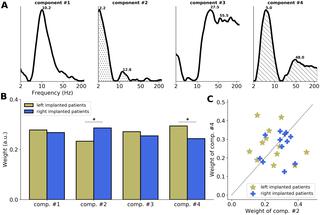当前位置:
X-MOL 学术
›
PLOS Biol.
›
论文详情
Our official English website, www.x-mol.net, welcomes your feedback! (Note: you will need to create a separate account there.)
Asymmetric sampling in human auditory cortex reveals spectral processing hierarchy.
PLOS Biology ( IF 9.8 ) Pub Date : 2020-03-02 , DOI: 10.1371/journal.pbio.3000207 Jérémy Giroud 1 , Agnès Trébuchon 1, 2 , Daniele Schön 1 , Patrick Marquis 1 , Catherine Liegeois-Chauvel 1, 3 , David Poeppel 4, 5 , Benjamin Morillon 1
PLOS Biology ( IF 9.8 ) Pub Date : 2020-03-02 , DOI: 10.1371/journal.pbio.3000207 Jérémy Giroud 1 , Agnès Trébuchon 1, 2 , Daniele Schön 1 , Patrick Marquis 1 , Catherine Liegeois-Chauvel 1, 3 , David Poeppel 4, 5 , Benjamin Morillon 1
Affiliation

|
Speech perception is mediated by both left and right auditory cortices but with differential sensitivity to specific acoustic information contained in the speech signal. A detailed description of this functional asymmetry is missing, and the underlying models are widely debated. We analyzed cortical responses from 96 epilepsy patients with electrode implantation in left or right primary, secondary, and/or association auditory cortex (AAC). We presented short acoustic transients to noninvasively estimate the dynamical properties of multiple functional regions along the auditory cortical hierarchy. We show remarkably similar bimodal spectral response profiles in left and right primary and secondary regions, with evoked activity composed of dynamics in the theta (around 4-8 Hz) and beta-gamma (around 15-40 Hz) ranges. Beyond these first cortical levels of auditory processing, a hemispheric asymmetry emerged, with delta and beta band (3/15 Hz) responsivity prevailing in the right hemisphere and theta and gamma band (6/40 Hz) activity prevailing in the left. This asymmetry is also present during syllables presentation, but the evoked responses in AAC are more heterogeneous, with the co-occurrence of alpha (around 10 Hz) and gamma (>25 Hz) activity bilaterally. These intracranial data provide a more fine-grained and nuanced characterization of cortical auditory processing in the 2 hemispheres, shedding light on the neural dynamics that potentially shape auditory and speech processing at different levels of the cortical hierarchy.
中文翻译:

人类听觉皮层的不对称采样揭示了频谱处理层次。
语音感知是由左右两个听觉皮层介导的,但对语音信号中包含的特定声学信息具有不同的敏感性。缺少对该功能不对称的详细描述,并且对基础模型进行了广泛辩论。我们分析了96名癫痫患者在左或右原发,继发和/或联想听觉皮层(AAC)中植入电极的皮质反应。我们提出了短的声学瞬变,以非侵入性地估计听觉皮层层次的多个功能区域的动力学特性。我们在左右主要和次要区域显示出非常相似的双峰光谱响应曲线,诱发的活动由θ(约4-8 Hz)和β-γ(约15-40 Hz)范围内的动力学组成。除了听觉处理的这些第一皮质水平之外,还出现了半球不对称性,右半球占主导地位的是δ和β波段(3/15 Hz),而左侧则占主导地位的是theta和γ波段(6/40 Hz)。在音节呈现过程中也存在这种不对称性,但是AAC中引起的反应更加不均匀,双向同时出现α(约10 Hz)和γ(> 25 Hz)活动。这些颅内数据提供了两个半球中皮质听觉处理的更细粒度和细微差别的特征,揭示了可能在皮质层次的不同级别上影响听觉和语音处理的神经动力学。右半球主要具有delta和beta波段(3/15 Hz)的响应度,而左半部分则具有theta和gamma波段(6/40 Hz)的响应度。在音节呈现过程中也存在这种不对称性,但是AAC中引起的反应更加不均匀,双向同时出现α(约10 Hz)和γ(> 25 Hz)活动。这些颅内数据提供了两个半球中皮质听觉处理的更细粒度和细微差别的特征,揭示了可能在皮质层次的不同级别上影响听觉和语音处理的神经动力学。右半球主要具有delta和beta波段(3/15 Hz)的响应度,而左半部分则具有theta和gamma波段(6/40 Hz)的响应度。在音节呈现过程中也存在这种不对称性,但是AAC中引起的反应更加不均匀,双向同时出现α(约10 Hz)和γ(> 25 Hz)活动。这些颅内数据提供了两个半球中皮质听觉处理的更细粒度和细微差别的特征,揭示了可能在皮质层次的不同级别上影响听觉和语音处理的神经动力学。双向同时出现α(约10 Hz)和γ(> 25 Hz)活动。这些颅内数据提供了两个半球中皮质听觉处理的更细粒度和细微差别的特征,揭示了可能在皮质层次的不同级别上影响听觉和语音处理的神经动力学。双向同时出现α(约10 Hz)和γ(> 25 Hz)活动。这些颅内数据提供了两个半球中皮质听觉处理的更细粒度和细微差别的特征,揭示了可能在皮质层次的不同级别上影响听觉和语音处理的神经动力学。
更新日期:2020-04-16
中文翻译:

人类听觉皮层的不对称采样揭示了频谱处理层次。
语音感知是由左右两个听觉皮层介导的,但对语音信号中包含的特定声学信息具有不同的敏感性。缺少对该功能不对称的详细描述,并且对基础模型进行了广泛辩论。我们分析了96名癫痫患者在左或右原发,继发和/或联想听觉皮层(AAC)中植入电极的皮质反应。我们提出了短的声学瞬变,以非侵入性地估计听觉皮层层次的多个功能区域的动力学特性。我们在左右主要和次要区域显示出非常相似的双峰光谱响应曲线,诱发的活动由θ(约4-8 Hz)和β-γ(约15-40 Hz)范围内的动力学组成。除了听觉处理的这些第一皮质水平之外,还出现了半球不对称性,右半球占主导地位的是δ和β波段(3/15 Hz),而左侧则占主导地位的是theta和γ波段(6/40 Hz)。在音节呈现过程中也存在这种不对称性,但是AAC中引起的反应更加不均匀,双向同时出现α(约10 Hz)和γ(> 25 Hz)活动。这些颅内数据提供了两个半球中皮质听觉处理的更细粒度和细微差别的特征,揭示了可能在皮质层次的不同级别上影响听觉和语音处理的神经动力学。右半球主要具有delta和beta波段(3/15 Hz)的响应度,而左半部分则具有theta和gamma波段(6/40 Hz)的响应度。在音节呈现过程中也存在这种不对称性,但是AAC中引起的反应更加不均匀,双向同时出现α(约10 Hz)和γ(> 25 Hz)活动。这些颅内数据提供了两个半球中皮质听觉处理的更细粒度和细微差别的特征,揭示了可能在皮质层次的不同级别上影响听觉和语音处理的神经动力学。右半球主要具有delta和beta波段(3/15 Hz)的响应度,而左半部分则具有theta和gamma波段(6/40 Hz)的响应度。在音节呈现过程中也存在这种不对称性,但是AAC中引起的反应更加不均匀,双向同时出现α(约10 Hz)和γ(> 25 Hz)活动。这些颅内数据提供了两个半球中皮质听觉处理的更细粒度和细微差别的特征,揭示了可能在皮质层次的不同级别上影响听觉和语音处理的神经动力学。双向同时出现α(约10 Hz)和γ(> 25 Hz)活动。这些颅内数据提供了两个半球中皮质听觉处理的更细粒度和细微差别的特征,揭示了可能在皮质层次的不同级别上影响听觉和语音处理的神经动力学。双向同时出现α(约10 Hz)和γ(> 25 Hz)活动。这些颅内数据提供了两个半球中皮质听觉处理的更细粒度和细微差别的特征,揭示了可能在皮质层次的不同级别上影响听觉和语音处理的神经动力学。



























 京公网安备 11010802027423号
京公网安备 11010802027423号